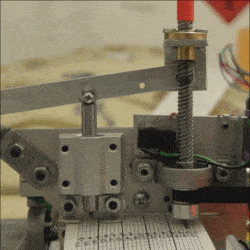
Most projects have one or two significant aspects in which custom work or clever execution is showcased, but this Music Box Hole Punching Machine by [Josh Sheldon] and his roommate [Matt] is a delight on many levels. Not only was custom hardware made to automate punching holes in long spools of paper for feeding through a music box, but a software front end to process MIDI files means that in a way, this project is really a MIDI-to-hand-cranked-music-box converter. What a time to be alive.
The hole punch is an entirely custom-made assembly, and as [Josh] observes, making a reliable hole punch turns out to be extremely challenging. Plenty of trial and error was involved, and the project’s documentation as well as an overview video go into plenty of detail. Don’t miss the music box version of “Still Alive”, either. Both are embedded below.
As [Josh] mentioned on his project page, he was inspired by a tutorial video showing how to punch music by hand. It led to this tool to take a MIDI file and cut the music paper out on a laser cutter, whereas [Josh] and [Matt] were inspired to automate the entire process in their own way.
For those of you who don’t think science should stop there, why not automate the creation of the music itself with the output of this Bach-emulating Recurring Neural Network?
Thanks to [Tim Trzepacz] for giving us a heads up on this delightful project!

















Most excellent. In a way, this is more inspiring than Wintergatan’s machine, since something like this is a more realistic goal for many of us.
why not use a solonoid?
Did you watch the video? They tried solenoids.
i had not. sorry
I think they had a lack of voltage/amperage on those solenoids.
I know how to use a solenoid….
What you want is some mechanism such as those in staple guns, which gradually load a spring until a tipover point and release energy in a swift movement….
This would be matched well to the characteristics of a solenoid where it is very weak at the furthest extent of it’s extension and gets very strong just as slug is fully pulled into coil.
You probably won’t need a very strong staple gun, if you wanna use one for the parts, just one of the ones that does desktop #8s or something.
Two immediate thoughts:
Pneumatic piston pushing the cutting die – this is the way most of your bulk paper gets punched (well, hydraulics, but that’s messy) – it would speed up the system by severalfold.
After all of that automation and programming…they hand-crank the music box. Adorable.
And they have to crank it pretty fast! Motorized box with tempo setting would be the next logical step.
Here you go: https://www.youtube.com/watch?v=OacXT6Nk0LE
Awesome !
This cake is great.
Really cool, though I believe someone pretty quickly came up with a laser cutter solution that makes a lot more sense.
Hey, Matt here, glad you liked it! There was a group that got a web tool up and running really fast for translating MIDI into vinyl cutter commands to make music box papers. It’s a really good solution, and a really cool project, we just wanted to gave a good time making a thing too :) In the video we talk briefly about pros and cons of each approach.
Here’s the video where Martin from Wintergatan talks about that team (also listed in the description of our video):
https://www.youtube.com/watch?v=XyVyA5ZdWOY
Oh hi, I’m Sebastiaan from the group! You made something awesome man!
Hey Mark,
Indeed, together with Martin we started a GitHub project. It’s listed above as the inspiration.
That was fantastic, from beginning to end. Now, please stick a motor to this music box. I got tired just watching you guys crank it :-)
Last year I built a 19th century perpetual motion machine in order to run a music box like this. It would have been able to play one of the massively long pieces of music that this machine could produce, if only the original perpetual motion machine design didn’t have 99 points of friction.
(And yes, it did need a motor to run perpetually.)
I’m very disappointed that I watched the entire video only to realize it wasn’t the Portal version of “Still Alive”.. “we do what we must because we can..”
Short clip under the main video…
Not every day you come to HAD and end up finding a new band that you really like.